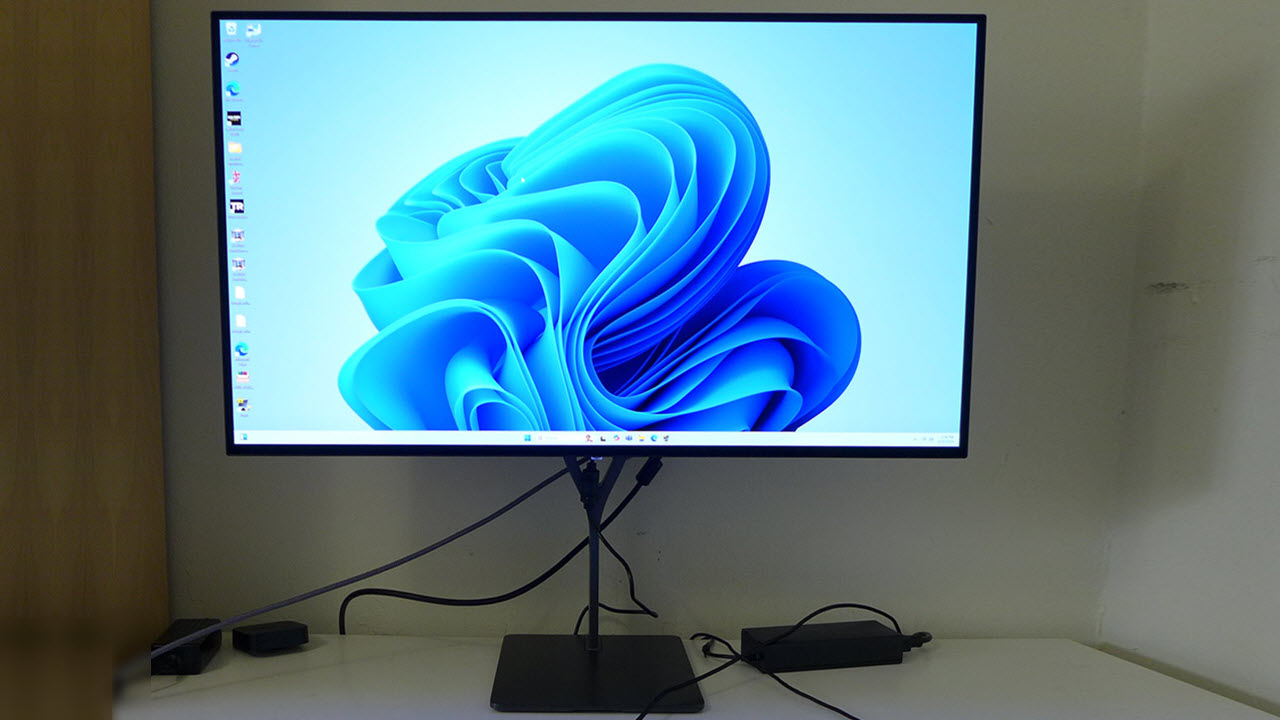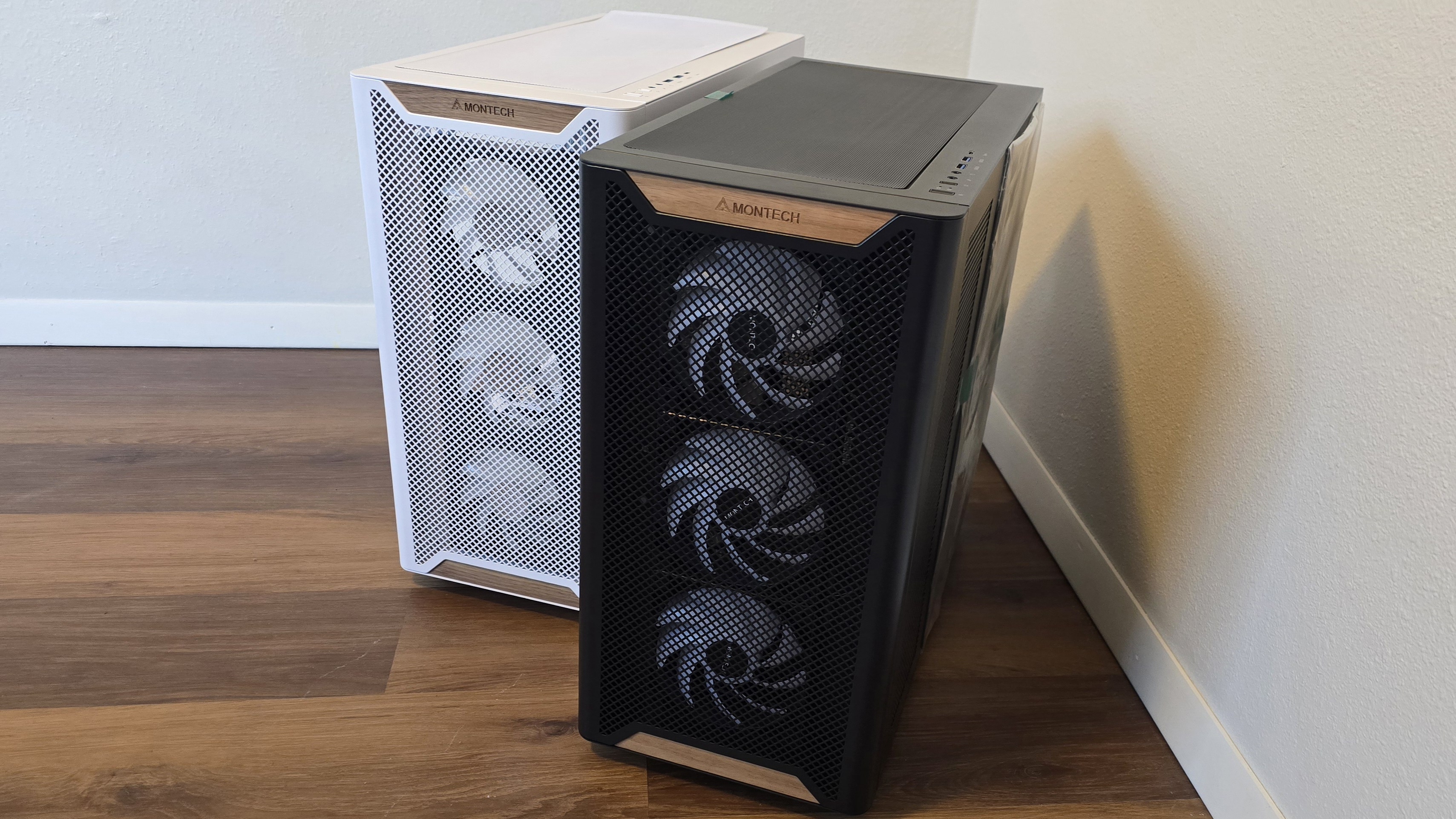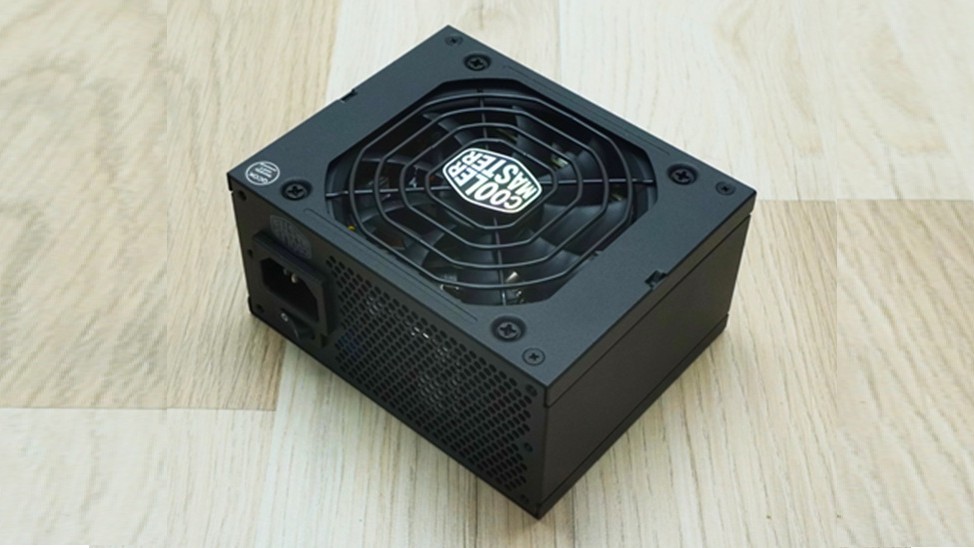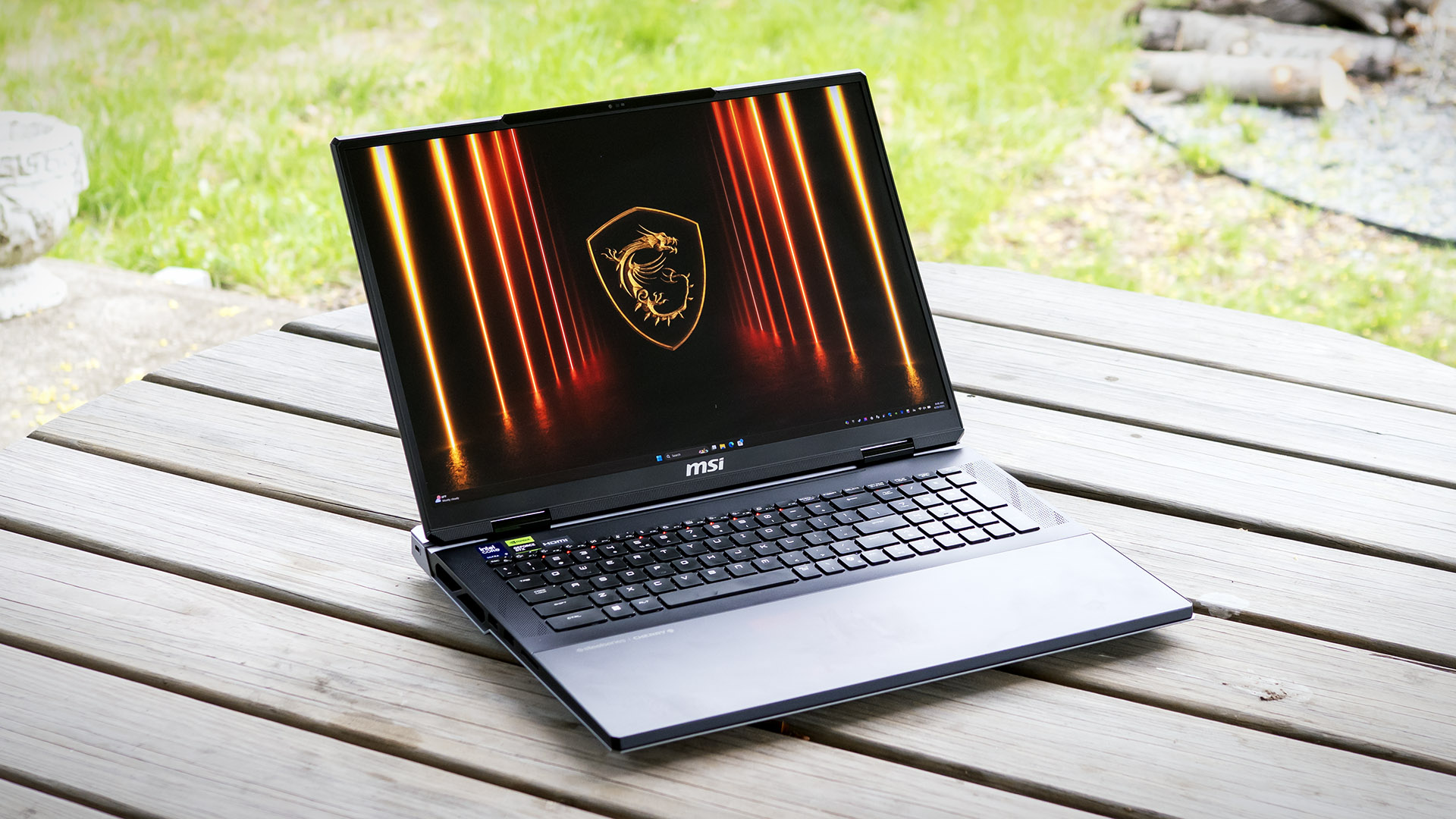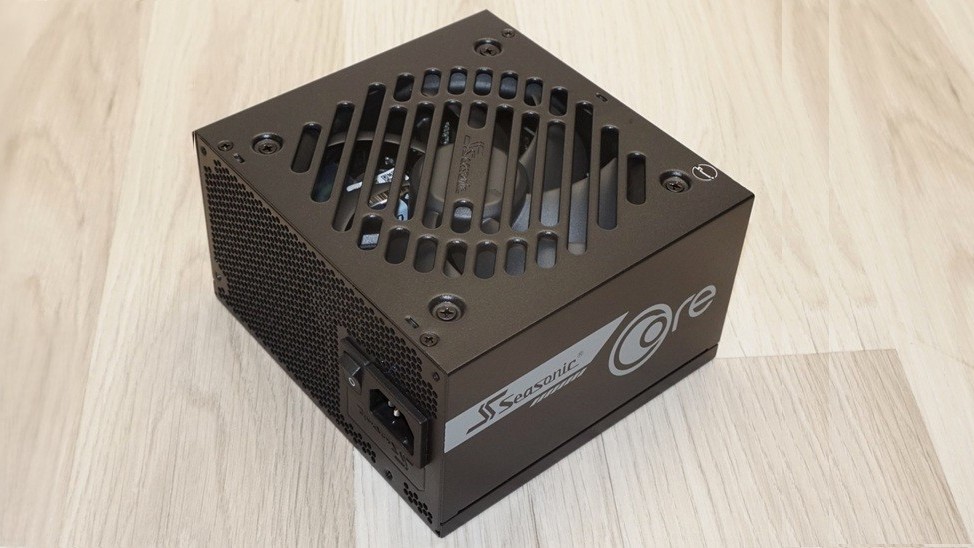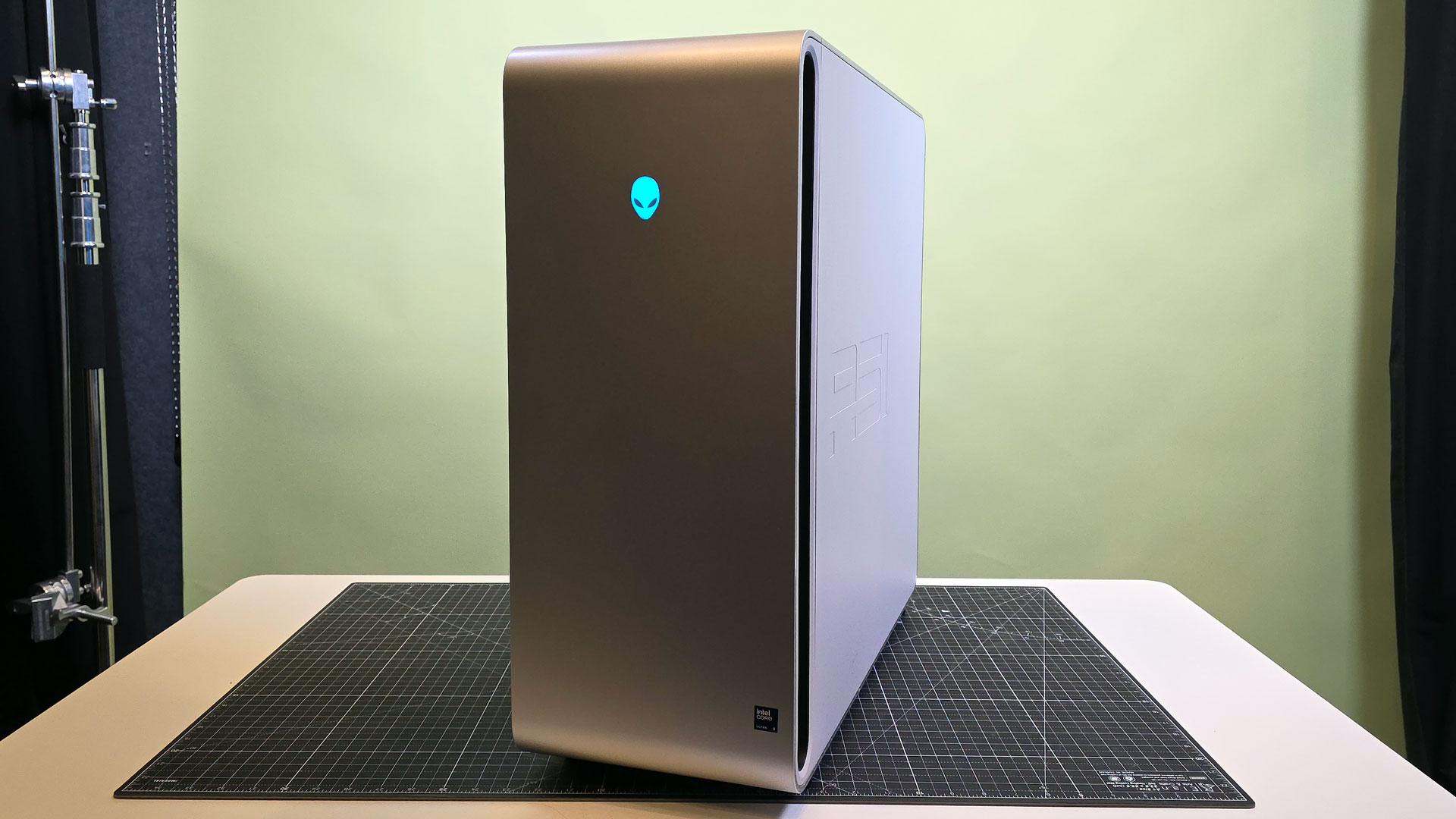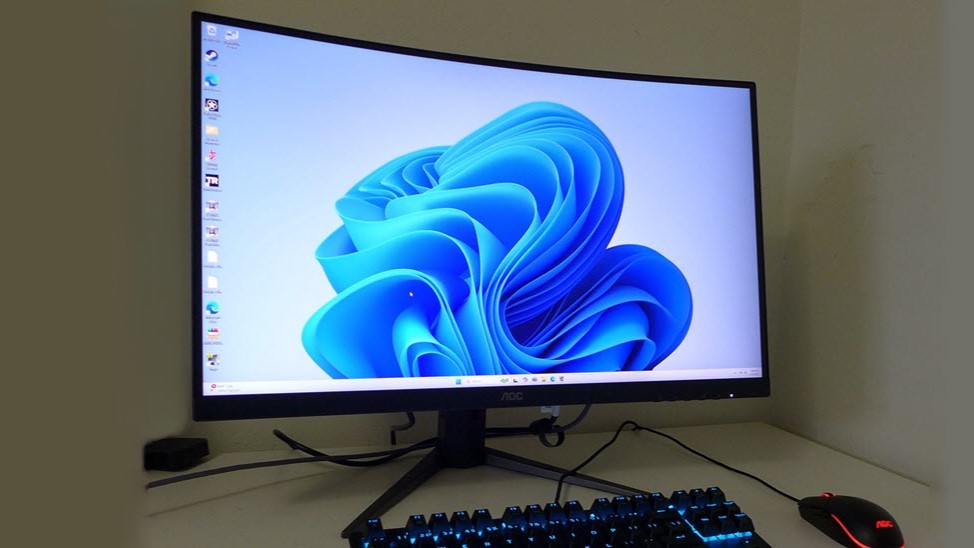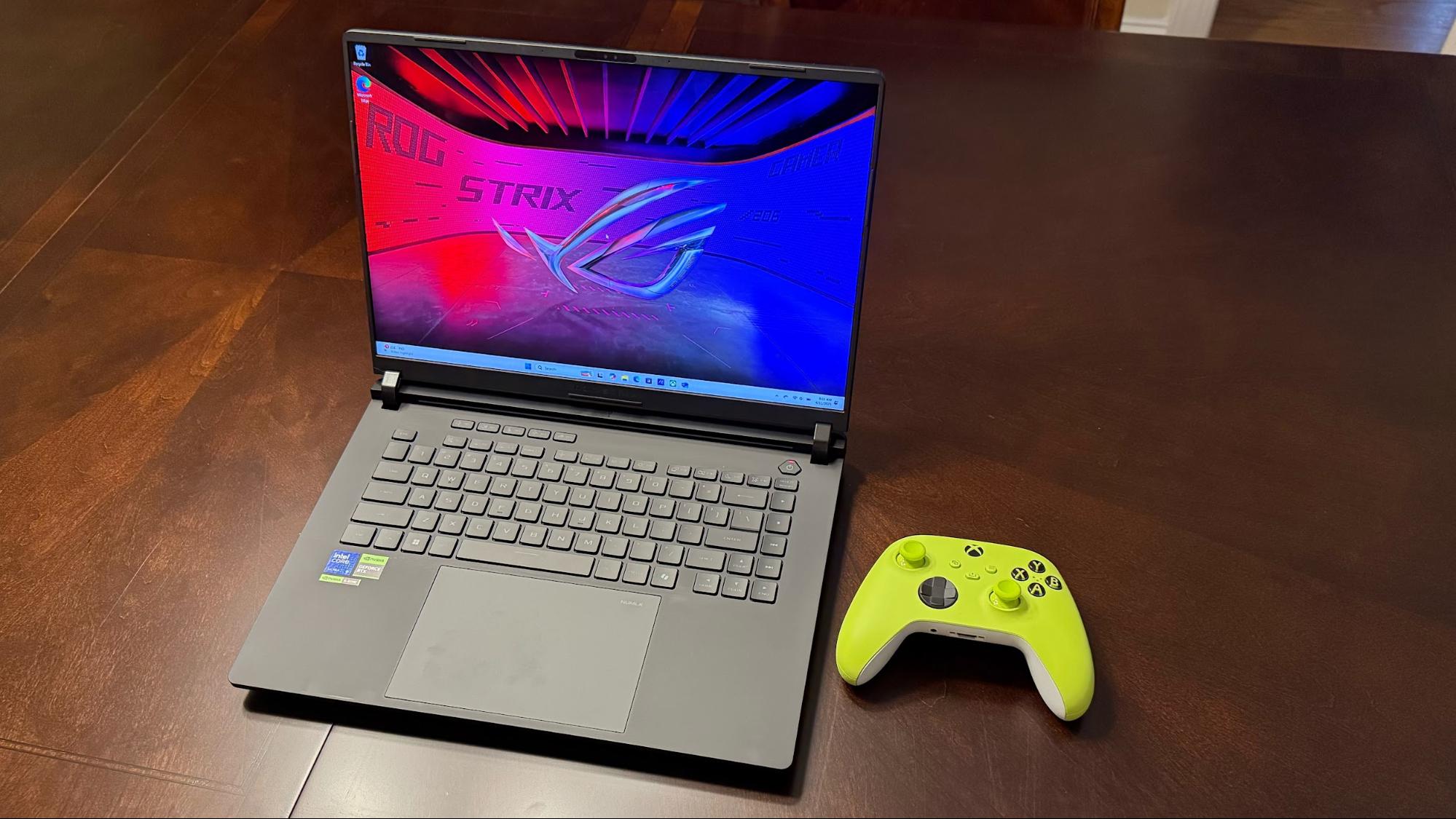Tom's Hardware Verdict
The ViewSonic Elite XG321UG delivers tremendous contrast and color saturation for stunning picture quality. Gaming performance is as good as it gets for Ultra HD resolution and 144 Hz. It’s a significant purchase, but for the money, you won’t find a better picture from any other LCD panel.
Pros
- +
Stunning image with deep contrast
- +
Huge color gamut
- +
Nvidia Reflex Latency Analyzer
Cons
- -
No HDMI 2.1
- -
No backlight strobe option
- -
Expensive
Why you can trust Tom's Hardware
Of all the bleeding edge tech available in today’s gaming monitors, one of the most exclusive is Mini LED. While typical LCD backlights consist of LEDs arrayed at the edge of the panel or a grid of LEDs behind the TFT layer with up to 512 dimming zones, Mini LEDs are tiny light sources that boost peak output and sport as many as 1152 dimming zones. With this many zones, contrast can be much broader, making both SDR and HDR content richer and more dynamic.
The downside to Mini LED is cost. You’ll pay well over $2,000 for a 32-inch Ultra HD Mini LED gaming monitor. I’ve already checked out Asus’ version, the ROG Swift PG32UQX, which sells for around $2,900. Now we have the ViewSonic Elite XG321UG, which is a shoo-in to be featured among the best gaming monitors. It has the same basic specs: Ultra HD resolution, Mini LED 1,152-zone backlight, 144 Hz, HDR with 1,400 nits peak, Nvidia G-Sync Ultimate and a super-wide color gamut. ViewSonic adds the latest G-Sync Processor features with Nvidia’s Reflex Latency Analyzer, and the price is a tad lower, $2,499 to start.
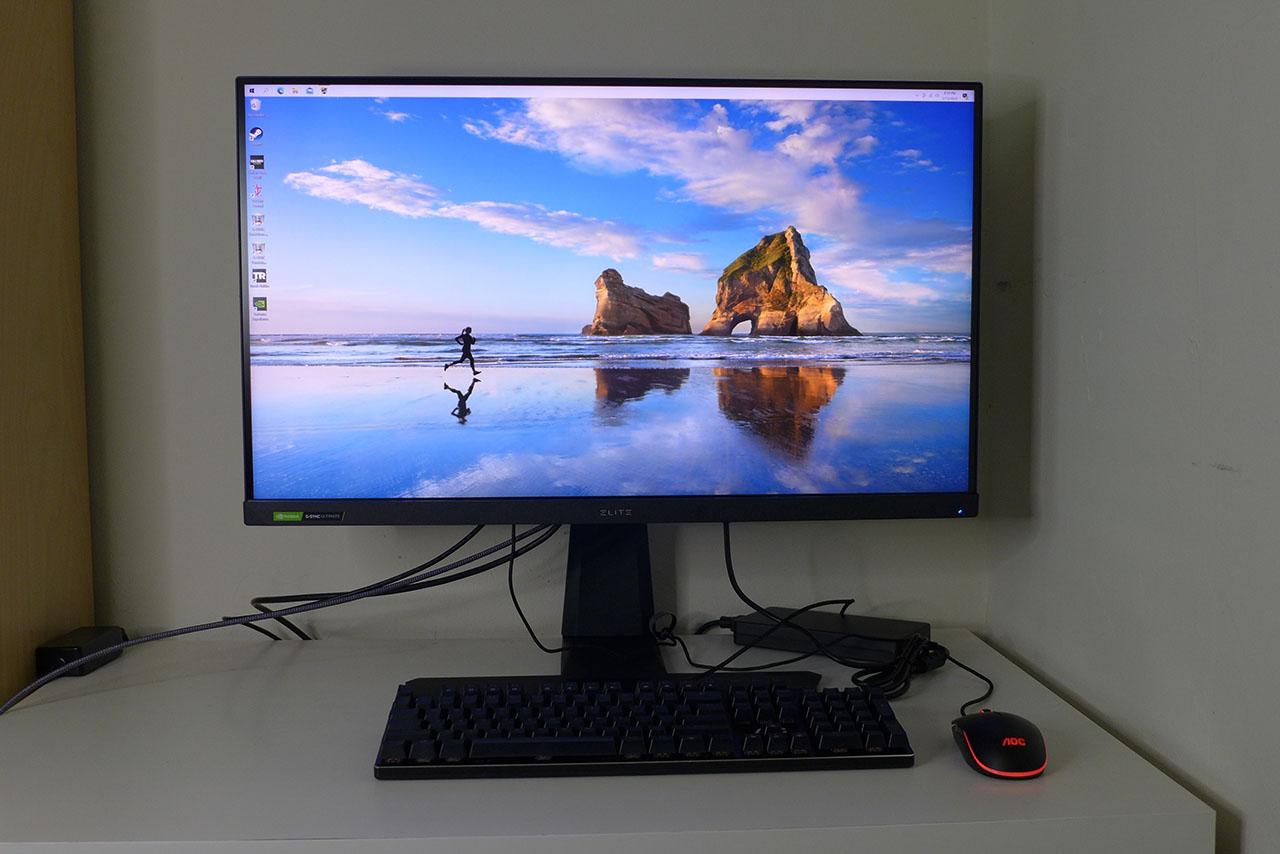
ViewSonic Elite XG321UG Specs
| Panel Type / Backlight | IPS / Mini LED |
| Row 1 - Cell 0 | Full array, 1152 dimming zones |
| Screen Size / Aspect Ratio | 32 inches / 16:9 |
| Max Resolution and Refresh Rate | 3840x2160 @ 144 Hz |
| Row 4 - Cell 0 | G-Sync Ultimate |
| Row 5 - Cell 0 | FreeSync compatible |
| Native Color Depth and Gamut | 10-bit / Rec.2020 |
| Row 7 - Cell 0 | HDR10, DisplayHDR 1400 |
| Response Time (GTG) | 3 ms |
| Brightness (mfr) | 400 nits SDR |
| Row 10 - Cell 0 | 1,400 nits HDR |
| Contrast (mfr) | 1,000:1 |
| Speakers | 2x 5w |
| Video Inputs | 1x DisplayPort 1.4 w/DSC |
| Row 14 - Cell 0 | 3x HDMI 2.0 |
| Audio | 3.5mm headphone output |
| USB 3.1 | 1x up, 3x down or None |
| Power Consumption | 65.5w, brightness @ 200 nits |
| Panel Dimensions WxHxD w/base | 28.6 x 18.8-23.5 x 10.4 inches (726 x 478-598 x 265 mm) |
| Panel Thickness | 3.5 inches (88 mm) |
| Bezel Width | Top/sides: 0.3 inch (8 mm) |
| Row 21 - Cell 0 | Bottom: 1 inch (25 mm) |
| Weight | 24 pounds (10.9 kg) |
| Warranty | 3 years |
When it comes to image quality, the XG321UG leaves nothing on the table. The IPS panel has the same Mini LED 1152-zone backlight as the Asus. Peak output is rated at 1,400 nits in HDR mode, but I measured over 1,700 with a window pattern. That’s seriously bright. HDR contrast is over 70,000:1 thanks to that fancy backlight which can shut down any part of its 48 by 24 zone array. Extended color comes courtesy of a quantum dot film which takes the color gamut well past DCI-P3, all the way to 84.28% coverage of Rec.2020. Accuracy is assured out of the box, and there’s even a near-perfect sRGB mode for SDR content. As you’ll see in the benchmark tests, the XG321UG excels in image fidelity and performance.
Gaming performance is premium with a 144 Hz refresh rate, G-Sync Ultimate and FreeSync compatibility. The XG321UG is the first Ultra HD monitor I’ve tested with Nvidia’s Reflex Latency Analyzer feature, something I’d only seen previously on 360 Hz displays. By connecting a supported mouse to the monitor’s special green USB port, you can see your exact control latency displayed in real-time while you play a game. It’s a great way to monitor performance and a helpful tool for esports enthusiasts.
Fans of LED lighting effects will find a glowing ring on the XG321UG’s backside and another light bar that shines a soft glow on the desktop. You also get convenient bits like a stout metal headphone hook, a carry handle on the upright and little cable managers that fold out to accommodate mouse and keyboard hookups. As expected, build quality is as good as it gets.
Assembly and Accessories
The XG321UG comes in a large clamshell box that opens wide, making the contents easy to lift. The all-metal base bolts to an equally massive upright to which the chunky panel is attached, no tools necessary. A cover comes off to reveal the input panel. Once your connections are made, put it back to hide the wiring. The accessory bundle consists of HDMI, DisplayPort and USB cables along with a huge external power supply, not surprising considering the 65 watts I measured with brightness at 200 nits.
Product 360
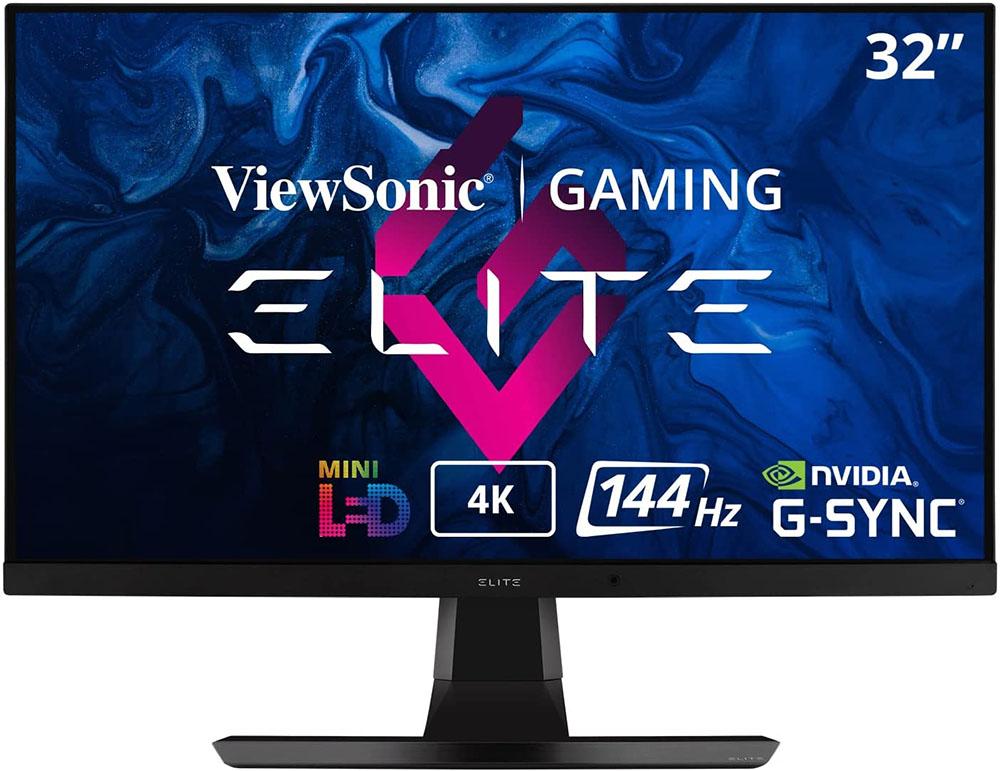
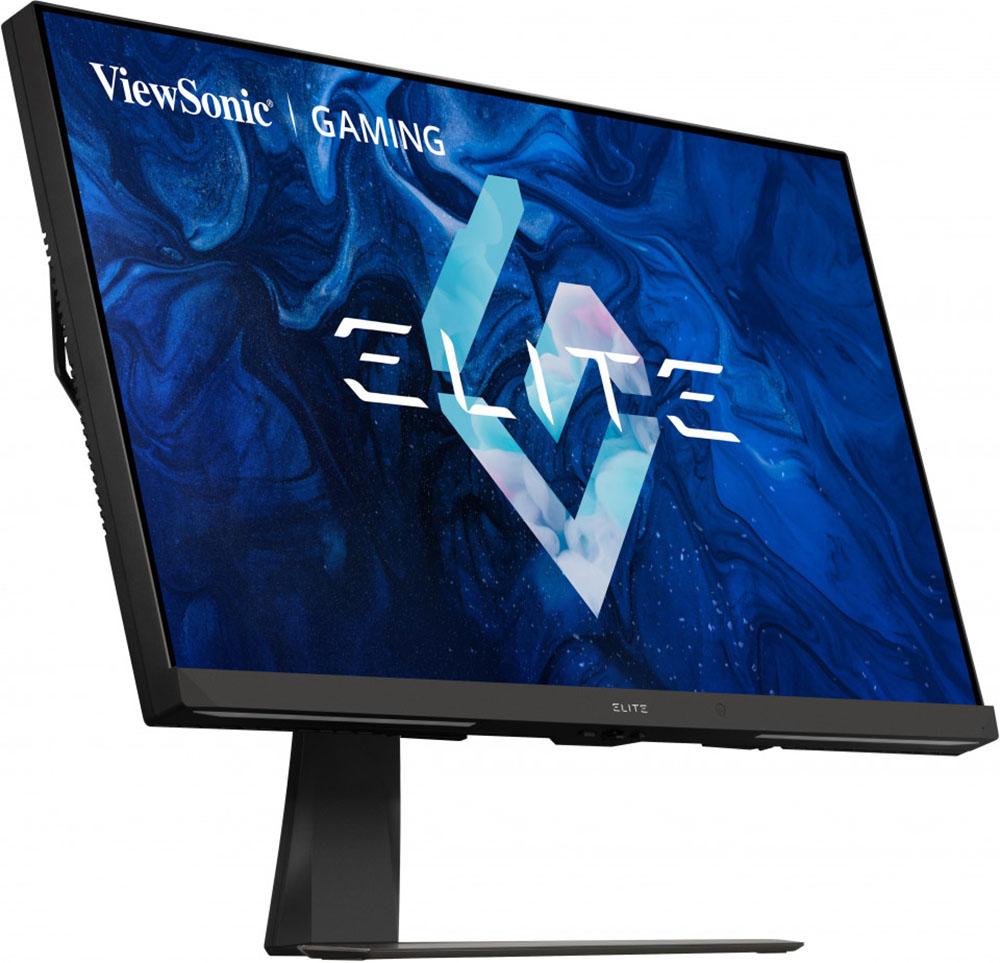
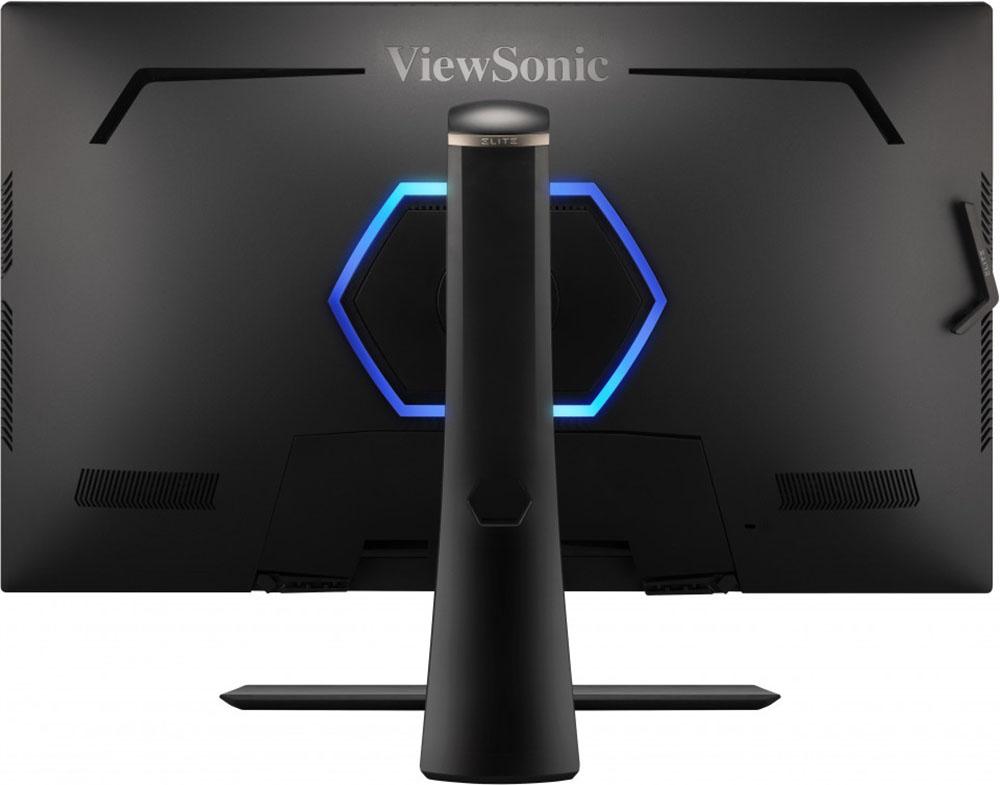
Despite a large and heavy chassis, the XG321UG appears slim from the front thanks to an 8 mm flush bezel around the top and sides of the screen. You’ll barely notice it when an image is displayed. A wider one-inch trim strip crosses the bottom with an Elite logo in the center. Below are two keys and a joystick for the OSD and power functions. The screen has a 3H hardness matte anti-glare layer.
The stand is rock solid and more than capable of supporting the large panel’s weight. Adjustments include 120 mm of height, 5/20 degrees tilt and 25 degrees swivel to either side. There is no portrait adjustment. The panel sits high enough to put the user’s eyepoint at the center screen on a typical desktop. If you’d rather set it down low, it nearly touches the desk surface with just enough clearance for cables.

From the side, you can see the panel’s thickness but a gentle taper from side to side makes it look a little less bulky. There is plenty of room here for USB or audio ports, but ViewSonic didn’t include them. You’ll find them on the input panel underneath. There are also three HDMI 2.0 ports plus a single DisplayPort 1.4 with Display Stream Compression. To use the full 10-bit native color bandwidth at 144 Hz with Adaptive-Sync and HDR, you’ll need to use DisplayPort. HDMI tops out at 120 Hz.
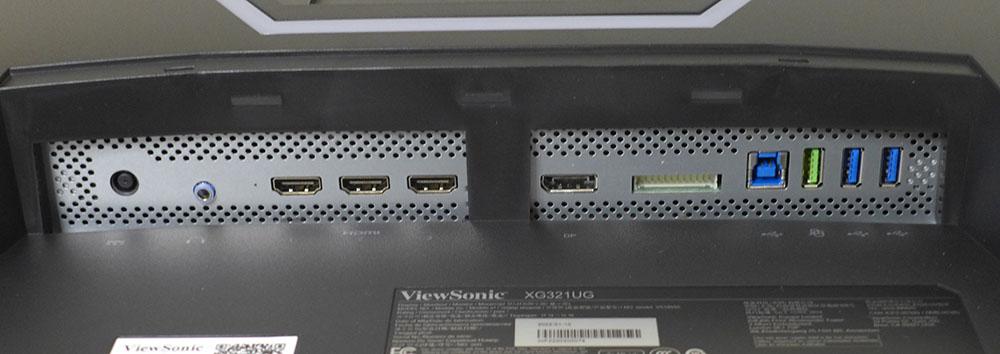
The LED lighting takes the form of diffuse bands that glow softly. A hexagon rings the stand mount, which hides a 100 mm VESA bolt pattern. And you get another bar across the bottom of the bezel, which casts light on the desktop. All colors and effects are controlled by the OSD and can be turned off if you wish. Also included is a room light sensor for the Auto Brightness and Auto Black Level functions. They tweak the image in real-time to optimize it for your room’s lighting conditions.
OSD Features
The XG31UG’s OSD has a very functional look with nothing but text and thin lines to delineate its six sub-menus. There are no gaming graphics or futuristic shapes here. To call it up, press the joystick under the center of the panel.

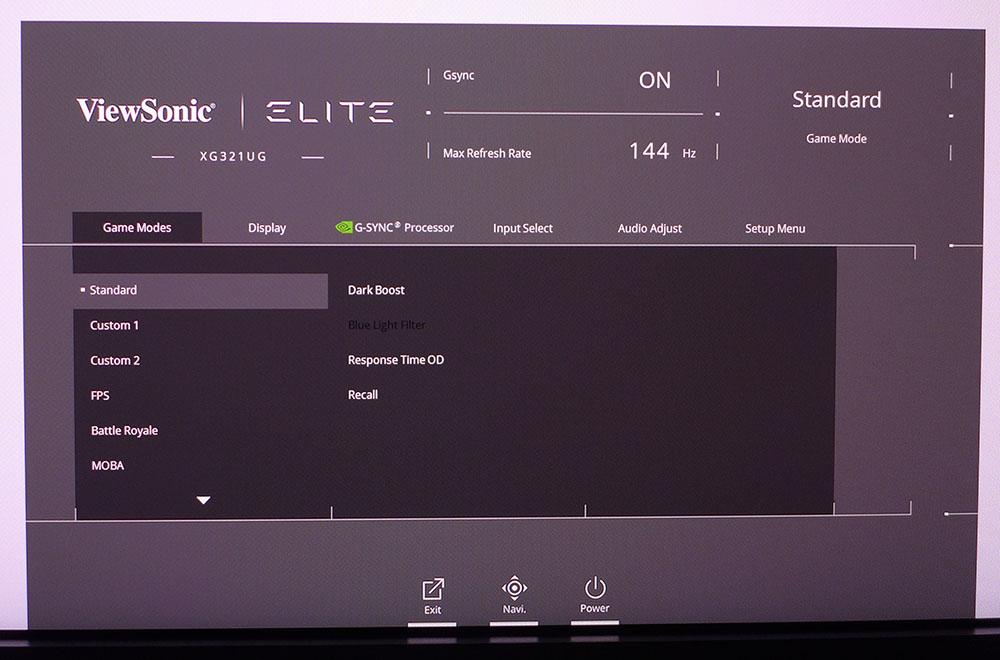
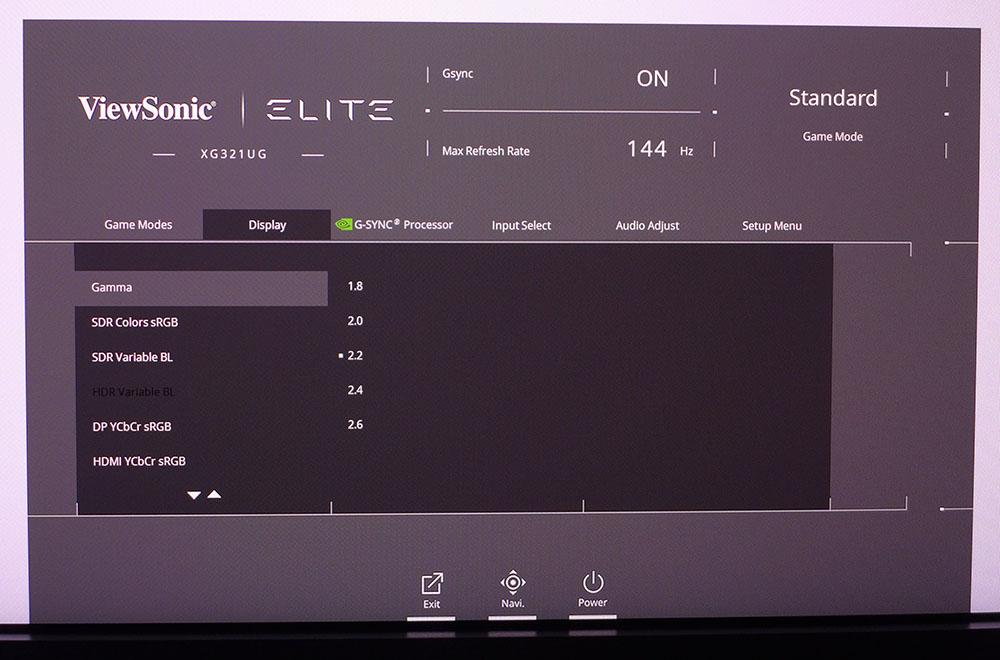

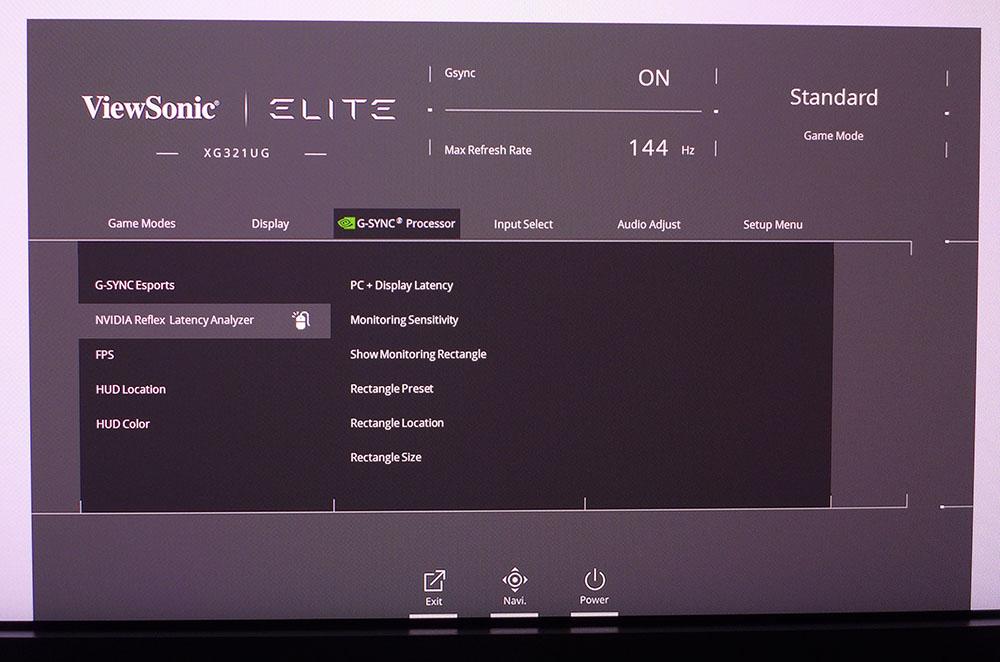
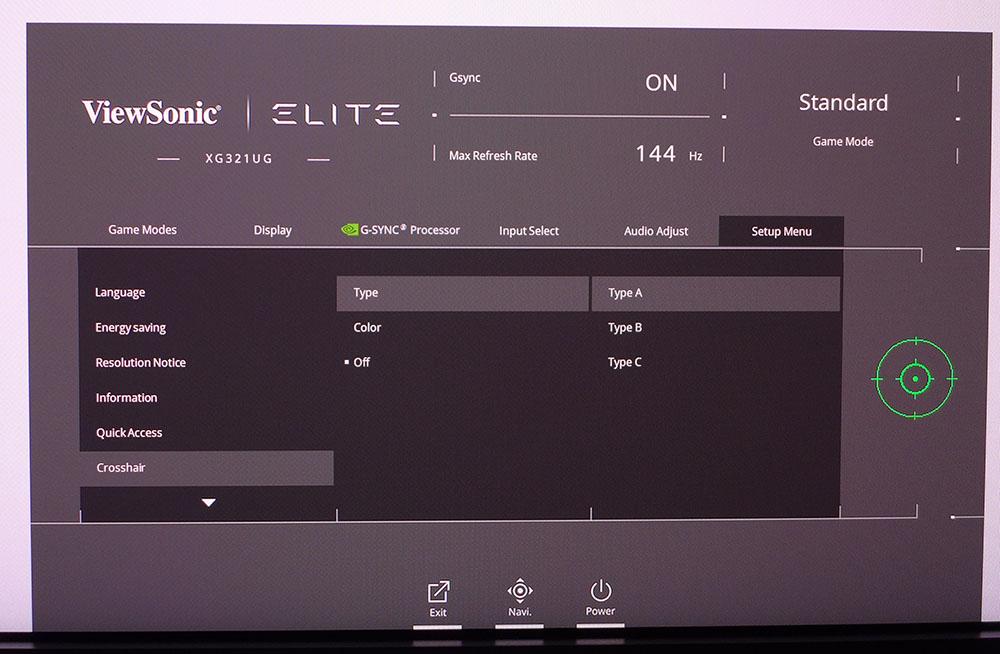
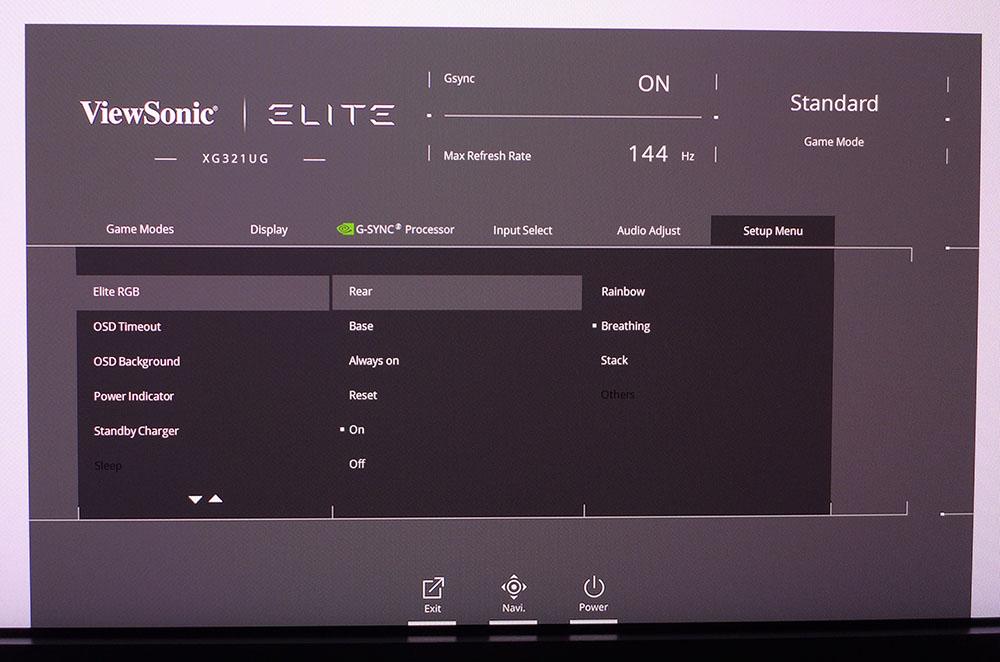
There are nine picture modes in total, with Standard being the best one for accuracy. It doesn’t need calibration, but a few tweaks put the XG321UG on par with the very best displays I’ve tested. You can choose between four color temp presets and five gamma options. The RGB sliders are very precise and can get the grayscale errors down to a super-low level. Auto Brightness and Auto Black Level work with the sensor on the panel’s front to tweak the image automatically. They’re a bit aggressive at times, so I recommend using them sparingly.
The XG321UG is one of the few wide-color screens with a selectable gamut. By turning the SDR Colors sRGB option on, you can use sRGB for all SDR content. When an HDR signal is detected, the monitor switches to its full native gamut, which is quite large, over 84% of Rec.2020. You can also use the variable backlight in SDR mode to improve contrast. It works well without crushing detail, upping the SDR contrast ratio to around 6,000:1. There are three modes that modulate the backlight more or less aggressively. Mode 1 looked best with the deepest blacks.
The XG321UG is the first non-360 Hz screen I’ve seen that includes the Nvidia Reflex Latency Analyzer. By making a USB connection to the PC, then plugging a compatible mouse into the special green USB port, you can see your control delay in real-time as you play. There are options for the monitoring window’s size and location. You can also display a frame rate indicator.
The Setup menu has three crosshair shapes available in green or red. You can also display signal info and program the joystick to provide quick access to some monitor functions. The Elite RGB feature has controls for the base or rear LED arrays with a variety of colors and effects to choose.
ViewSonic Elite XG321UG Calibration Settings
The XG321UG doesn’t need calibration in its Standard mode, but a slight improvement is possible with a few adjustments to the RGB sliders. The settings work identically for either sRGB or Rec.2020 color gamuts which is nice. I also found the custom color temp to work well in HDR mode. If you want the full color space for all content, turn off the SDR Colors sRGB option. When it’s turned on, the gamut will change automatically with signal type. You can also toggle the variable backlight on and off and select from three modes of operation. Mode 1 worked the best in my tests. If you’d like to optimize your XG321UG, check out my settings below.
| Picture Mode | Standard |
| Brightness 200 nits | 70 |
| Brightness 120 nits | 38 |
| Brightness 100 nits | 28 |
| Brightness 80 nits | 21 |
| Brightness 50 nits | 6 (min. 39 nits) |
| Contrast | 70 |
| Gamma | 2.2 |
| Color Temp User | Red 100, Green 92, Blue 87 |
Gaming and Hands-on
The XG321UG delivers a stunning image for both work and play. No matter what color gamut you use or whether it’s SDR or HDR, the picture is razor-sharp with beautifully saturated color. Native contrast is better than typical IPS panels at around 1,200:1, but you can up that ratio by using the Variable Backlight feature. It has three modes, of which number one is the best. It provides deep blacks and bright whites without crushing any shadow or highlight detail. Since it uses zone dimming to achieve its goals, colors look more saturated. And I never saw any instances of backlight flickering or dimming. It works seamlessly for both static and moving content.
Ultra HD video is truly epic here. Though 32 inches is a bit smaller than the average TV, the XG321UG is a perfectly capable television with a streaming box connected. When you sit three or four feet away, it creates an immersive image that’s great for a movie or TV series. I preferred Mode 1 for the Variable Backlight here; it has the deepest contrast. However, I wished for some sort of brightness adjustment. Daylight scenery is very bright, not harsh, but too much for a darkened room. The frame rate automatically matches content like 24 fps for film or 50 fps for European TV shows. HDR10 worked perfectly, but sadly, there is no Dolby Vision.
The audio quality is a cut above the norm for sure. The speakers sound a little boxy, but midrange and high frequencies play loud and clear without audible distortion.
Moving on to games, I was mesmerized by Doom Eternal and its deep shades of red. You won’t see these reds on any other monitor unless it can cover over 84% of Rec.2020 like the XG321UG. Some scenes looked as if they were soaked in blood. And texture was completely evident despite the tremendous color saturation. 1152 dimming zones are an order of magnitude better than the typical edge arrays found on HDR computer monitors. This monitor costs a lot, but you won’t find a better picture outside an OLED panel.
Video processing was excellent, with one exception – the overdrive is not aggressive enough. It has three levels, but I was stuck with the lowest one because the faster options caused too much ghosting. A little tweaking of the XG321UG’s firmware might yield some benefit here, and perhaps the addition of a backlight strobe option. There isn’t one here. Adaptive-Sync worked without issue on both G-Sync and FreeSync platforms. A GeForce RTX 3090 kept frame rates around 120 fps in Doom Eternal and Call of Duty WWII when playing in HDR mode.
Since I had an AOC GM500 Gaming Mouse on hand, I could try out the Reflex Latency Analyzer feature. I saw response times between 23 and 50 milliseconds as I played Doom Eternal. This is the first Ultra HD monitor I’ve seen with the feature. For a deeper dive into this, check out our article here.
HDR games were mesmerizing to look at. I found myself playing longer just to keep enjoying the stunning imagery. Game environments were incredibly realistic and smooth. Though I’ve experienced faster screens than the XG321UG, none were capable of the insane contrast on display here. Mini LED is a truly revelatory technology in the world of LCD panels.
Current page: Features and Specifications
Next Page Response, Input Lag, Viewing Angles and Uniformity
Christian Eberle is a Contributing Editor for Tom's Hardware US. He's a veteran reviewer of A/V equipment, specializing in monitors. Christian began his obsession with tech when he built his first PC in 1991, a 286 running DOS 3.0 at a blazing 12MHz. In 2006, he undertook training from the Imaging Science Foundation in video calibration and testing and thus started a passion for precise imaging that persists to this day. He is also a professional musician with a degree from the New England Conservatory as a classical bassoonist which he used to good effect as a performer with the West Point Army Band from 1987 to 2013. He enjoys watching movies and listening to high-end audio in his custom-built home theater and can be seen riding trails near his home on a race-ready ICE VTX recumbent trike. Christian enjoys the endless summer in Florida where he lives with his wife and Chihuahua and plays with orchestras around the state.
-
Heat_Fan89 Reply
Not only the price but what I would like to know what current video card can run games in 4K @ 144Hz at High settings? I recently purchased a 43" ASUS ROG 4K HDR monitor for $799 and I am quite happy. No way would I drop $2500 for a 32" monitor. I'd rather buy an LG C2 OLED TV for that price.Kridian said:It's comical! Who's paying these prices?!
No one. -
Greg7579 I'm a photographer who shoots Fuji Medium Format (GFX) gear as well as Leica full frame. I'm a resolution junkie for my image files and have been using Asus 32- inch 4k IPS monitors since day 1 (many years).Reply
I'm not a gamer but do build my own high-end gaming PCs (with some help from a gamer builder friend) to use with Photoshop / Lightroom and working with and viewing my hundreds of thousands of images.
Anyway, since the release of the 5 grand ASUS Mini-LED Pro monitors, I know I'm going mini-LED. But I wasn't ready to spend 5 grand for the past year or so.
I shoot and edit no video, but am addicted to the 32 inch 4K IPSs monitors I have had for working with for the past 7 years with my big raw files. Viewing them on those monitors is incredible and I just can't imagine any serious photographer not having one these days (the basic 4K IPS LED that now can be had for under a grand). The fact that this mini-LED 4k 32 incher is only 1500 bucks is amazing.
So I want a mini-LED 32 inch 4K Pro display, and this is it.
I'm getting this monitor based solely on this review. I don't care about the gaming specs, but I can get everything the top-end Professional mini-LED monitors have for less money with this baby, and not sacrifice anything on the productivity end.
For the past 7 years, one had to choose between Pro monitors or gaming monitors. This baby can give me the pro end while having all that gaming capability at my disposal (which could have other benefits even though I don't game).
One question: Will this high-end HDR capability be noticeable or beneficial when viewing and editing 100 MB raw files in the LightRoom and Photoshop? Will it be beneficial when viewing the full-size 40 MB exported jpegs on the various viewing platforms for still images? -
enjoiskaterguy :rolleyes:Reviewer did i great job reviewing this monitor but missed a CRUCIAL metric to evaluate; The Mini-LED halo-ing "glow" effect that is present in all Mini-LED displays. This effect can be noticed when moving your mouse cursor over a black or dark background.Reply
This was a huge missed opportunity during the reviewing process.
If the reviewer happens to read this, please let us fellow consumers know the level of haloing (glowing effect) this monitor has. Thank you! -
BoredErica Reply
Old games exist.Heat_Fan89 said:I would like to know what current video card can run games in 4K @ 144Hz at High settings?
Also with next gen coming soon, Minecraft RTX + DLSS will be a breeze.
I play 8k on some games at high refresh rates. -
enjoiskaterguy Reply"
I play 8k on some games at high refresh rates.
I would LOOOOVE to know how you manage to play in native 8k @ "high refresh rates". -
BoredErica Reply
Not sure if sarcasm, curiosity, or genuinely never played old games?enjoiskaterguy said:I would LOOOOVE to know how you manage to play in native 8k @ "high refresh rates".
Oblivion, Fallout 3, Fallout NV, The Last Remnant. Wolfenstein: Enemy Territory can do x4 SS. Yes, 16k gaming. I'm sure there are many other old games out there beyond whatever I happen to play. Minecraft without raytracing. Minecraft WITH raytracing is not too far off either. (45fps w/ 4090ti x2 for next gen = 90FPS, turn down chunks from max or wait for gen after that and voila, path traced, 8k, 120fps.)
In the future, DLSS/FSR2 will help make running current gen games at 8k easier. Of course, that would be for future hardware. -
enjoiskaterguy Replydark_wizzie said:Not sure if sarcasm, curiosity, or genuinely never played old games?
Oblivion, Fallout 3, Fallout NV, The Last Remnant. Wolfenstein: Enemy Territory can do x4 SS. Yes, 16k gaming. I'm sure there are many other old games out there beyond whatever I happen to play. Minecraft without raytracing. Minecraft WITH raytracing is not too far off either. (45fps w/ 4090ti x2 for next gen = 90FPS, turn down chunks from max or wait for gen after that and voila, path traced, 8k, 120fps.)
In the future, DLSS/FSR2 will help make running current gen games at 8k easier. Of course, that would be for future hardware.
My comment was part sarcastic and part frustration. Even though you may seem versed in computer hardware and getting high frame rates I will try to make this as clear as possible to dispell your previous claims so as to make more position more understanding....
So......There are ZERO monitors or TVs as of 2022 that NATIVELY (inherently with no downscaling/upscaling trickery like DLSS) run @ 8K over 60fps. PERIOD. FULL STOP! Stated differently there is currently zero options to get an 8k display that supports over 60hz.
Additionally, even if you are upscaling x2 on a 4k monitor with DLSS type tech you will stil be visually limited by pixel density of a 4k panel. There is NO point to upscale modern titles to 8k if the end user will not visuallly benefit from it. (this is different than post-processing over-sharpening which is a different conversation)
So your base claim that you are able to run 8k at "High refresh rates" is NOT visually achievable with current screen technology no matter what computer hardware you have. -
BoredErica Reply
There are no high refresh rate 8k displays and I claim to game at 8k high refresh rates. How is this possible? It's easy to infer it's DSR. DSR is DOWNSCALING. You RENDER at 8k and DOWNSCALE to 4k. You have it ass backwards because you are totally lost and have no idea what I was saying. Next time if you see a term and don't understand like "x4 SS", just ask.enjoiskaterguy said:My comment was part sarcastic and part frustration. Even though you may seem versed in computer hardware and getting high frame rates I will try to make this as clear as possible to dispell your previous claims so as to make more position more understanding....
So......There are ZERO monitors or TVs as of 2022 that NATIVELY (inherently with no downscaling/upscaling trickery like DLSS) run @ 8K over 60fps. PERIOD. FULL STOP! Stated differently there is currently zero options to get an 8k display that supports over 60hz.
Additionally, even if you are upscaling x2 on a 4k monitor with DLSS type tech you will stil be visually limited by pixel density of a 4k panel. There is NO point to upscale modern titles to 8k if the end user will not visuallly benefit from it. (this is different than post-processing over-sharpening which is a different conversation)
So your base claim that you are able to run 8k at "High refresh rates" is NOT visually achievable with current screen technology no matter what computer hardware you have.
DSR is essentially a form of ordered-grid supersampling. TAA is not a perfect AA and has issues with ghosting and blur that can be worse in movement rather than being still. The blur decreases as render resolution increases even if the output resolution is the same. With supersampling, textures can also get sharper due to better texture sampling. Subpixel level detail improves. 8k render downscaled to 4k is not as good as 8k render displayed by 8k monitor, but it beats 4k render displayed by 4k monitor. Supersampling is not new. Do some basic reading.
https://www.anandtech.com/show/8526/nvidia-geforce-gtx-980-review/6and
https://techreport.com/review/27102/maxwells-dynamic-super-resolution-explored/
Example of subpixel/pixel level detail:
1080p native: https://techreport.com/r.x/dsr-capture/mill-1920.png4k DSR (Render 4k, downscale to 1080p): https://techreport.com/r.x/dsr-capture/mill-3840.png
Notice how the rope is straight up missing on right hand side at 1080p native. This is easiest to see in fine lines at a distance. Fences, ropes, to lesser extent grass at a distance. And also, "DLSS hype tech"? ...Really?
You lack basic information. That's all I got to say, I'm done.
